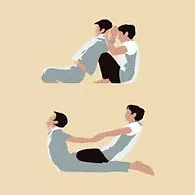Thai Yoga Massage
Traditional Thai Yoga Massage is an ancient Thai healing art. A dry massage, it is based on an energy line system (10 Sen) that distributes life force throughout the body.
Blocks in these energy lines cause aches, pains and disease. Stretches are combined with pressure using hands, feet, knees and elbows on important points along these lines. The release of the blocked energy restores balance, health and harmony.
Thai Yoga Massage
Traditional Thai Yoga Massage is an ancient Thai healing art. A dry massage, it is based on an energy line system (10 Sen) that distributes life force throughout the body.
Blocks in these energy lines cause aches, pains and disease. Stretches are combined with pressure using hands, feet, knees and elbows on important points along these lines. The release of the blocked energy restores balance, health and harmony.
Thai Yoga Massage gradually opens up the body, increasing joint flexibility. As muscular tension is released, there is free flow of blood and energy to the tissues and organs. The lymph system is stimulated, which helps the natural detoxification process and strengthens immune response.
The free flow of energy has both physical and psychological beneficial effects. It releases tension and opens up the entire body, thereby alleviating common ailments such as lower back pain, arthritis, headaches, digestive difficulties, menstrual problems and stress-related conditions.
Thai Yoga Massage takes both the client and the practitioner into a deep state of relaxation and well being.
Thai Yoga Massage gradually opens up the body, increasing joint flexibility. As muscular tension is released, there is free flow of blood and energy to the tissues and organs. The lymph system is stimulated, which helps the natural detoxification process and strengthens immune response.
The free flow of energy has both physical and psychological beneficial effects. It releases tension and opens up the entire body, thereby alleviating common ailments such as lower back pain, arthritis, headaches, digestive difficulties, menstrual problems and stress-related conditions.
Thai Yoga Massage takes both the client and the practitioner into a deep state of relaxation and well being.
Since most of the postures come from the Yoga tradition, Thai Yoga Massage includes the benefits of Yoga. In our method, students also learn about Yoga philosophy and its application for the well-being of the individual.
Thai Massage is done on a firm, supportive mat or futon on the floor. Light clothing is advisable for best results.
Since most of the postures come from the Yoga tradition, Thai Yoga Massage includes the benefits of Yoga. In our method, students also learn about Yoga philosophy and its application for the well-being of the individual.
Thai Massage is done on a firm, supportive mat or futon on the floor. Light clothing is advisable for best results.
10-12 Days Beginner Course
in Thai Massage
Outline:
Beginner course of 10 days spread over 2 weeks (5 hours each day).
2 additional practice days on request.
Each lesson begins with a lecture and demonstration followed by supervised practice in pairs.
Instruction Manual provided.
Content:
General background, history and theory.
Feet: Massaging the feet and loosening up exercises, pressure points and ankle stretches.
Energy lines on the legs: Working along the energy lines on the legs, three on the inside and two on the outside of each leg.
Single leg exercises: Applying several Yoga-based stretches on one leg at a time.
Double leg exercises: Applying several Yoga-based stretches on both legs together.
Stomach, Chest and Arms: Massage of these parts of the body. Includes points on the abdomen and chest.
Side position: Working along the third outside energy line on the legs, plus some kidney stretches and two spinal twists. All applied with the person lying on the side.
Back of the body: Massage of the back of the body. Walking on the feet, pressure points along the 2 main energy lines of the back, some more leg stretches and cobra stretch.
Sitting position: Massage of the shoulders and neck in the sitting position. Includes many shoulder and neck stretches and another spinal twist.
Face: Massage of the face. Includes basic therapeutic pressure points to treat various problems.
Finishing touch.
Detailed theory: Review of the 10 main energy lines (10 Sen), names, locations and therapeutic qualities. Comparison of Thai Massage with Chinese concepts of Acupressure / Shiatsu and the Indian philosophy of the Prana system. A sequence of techniques and therapeutic pressure points to treat and relieve headache, knee pain, lower back pain, etc.
Practicing a whole massage under supervision. The student will receive detailed feedback with advice, cautions and recommendations for future practice.












